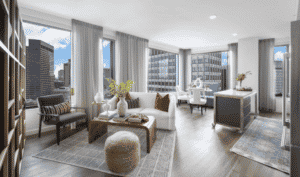
Developers are starting to reduce once-aggressive incentives to lure leasing activity at luxury apartment properties in Boston. The 368-unit Sudbury tower currently offers 1.5 months free rent on many units. Image courtesy of HYM Investment Group
It’s still a renter’s market for luxury apartments in Boston, but it doesn’t look like that’s going to last much longer.
Real estate industry executives report that the rental market in bouncing back after a year marked by a pandemic-induced exodus of tenants from urban areas to suburban locales. The trend spurred a once- unheard-of phenomenon in Boston: Falling occupancy rates and rent prices both for high-end and lower-end apartments.
Boston’s rental prices are still down 4 percent year-over-year from their pre-pandemic levels, according to data from Apartment List, an online rental platform that tracks rent prices across the country.
Nevertheless, Boston has now seen five straight months of rent increases, slowly regaining a large portion of last year’s average 20 percent plunge in rental prices, according to Apartment List data. The reason for the steady upsurge: Tenants are steadily returning to urban areas after the recent successful vaccine rollout and reopening of the economy in Massachusetts.
Leasing Velocity Stages Comeback
The rebound appears to be strongest for lower-end apartments, roughly defined by Apartment List as units going for $3,000 or less per month, while the higher-end luxury market seems to be recovering a bit more slowly.
For luxury apartments, the recovery has been strong enough for landlords to start scaling back some, though not all, of the pandemic-era concessions they were offering tenants in 2020.
At the recently-opened The Sudbury in downtown Boston – at the site of the old Government Center Garage – HYM Investment Group late last year had been offering about 2.5 months of free rent concessions to entice people to lease one of its 368 units, Managing Director Executive Tom O’Brien said.
“I was a little anxious,” O’Brien said of the initial “slowish” lease-up at The Sudbury, which started marketing units last October. “It was tough late last year and early this year. But it’s really picked up, big time, over the past few months.”
As a result, The Sudbury is now offering only 1.5 months of free rent on average in concessions to tenants.
“The face rent was $6 per foot pro-forma rent, which is a pretty good number, and we’re still getting that,” O’Brien said.
Rents at The Sudbury are clearly in the luxury-level category, ranging from $3,759 to $4,447 for one-bedroom apartments and from $5,455 to $8,214 for two-bedroom units. Rents for three-bedroom units go as high as $11,855 a month.
HYM declined to release its current occupancy levels, but O’Brien said new tenants include many young professionals and some medical students.

The first phase of the Overlook at St. Gabriel’s in Brighton passed the 60-percent occupancy rate in May, with more than 200 units spoken for. Another 237 units became available this month with the opening of its fourth and final building, Overlook West, at 161-185 Washington St. Image courtesy of Cabot, Cabot & Forbes
Demand Returns in Brighton
At the new Overlook at St. Gabriel’s in Brighton Allie Sullivan, a vice president at Cabot, Cabot & Forbes, said her development firm last year had been offering two months of free rent as concessions for all 555 units at the 12-acre site, a former monastery.
Today, it’s offering concessions only for studio units, due to the strong demand for one- and two-bedroom apartments, Sullivan said. The average rent at The Overlook is $3,300, with three-bedrooms going for up to $5,293.
Last year, only 70 units were leased, but so far this year 301 apartments have been rented out, Sullivan said. If current trends hold, the project could be fully occupied by the end of the year, she added.
“Last year was really, really tough,” Sullivan said. “Everything that could go wrong did go wrong. But it’s improved a lot. We’re getting there.”
Sue Hawkes, managing director at The Collaborative Cos., said the luxury-apartment market has definitely improved in Boston.
“It’s been an amazing vertical trajectory,” she said of the performance of some higher-end properties that her firm represents.
The new 450-unit Hub50House, which was developed by Boston Properties and started leasing in 2019, was about 50 percent occupied pre-COVID-19, Hawkes said. Then the pandemic hit and lease activity dried up, requiring the owners to offer prospective tenants one to two free months of rent in concessions, she said.
But today, thanks to an influx of young professionals and others back into the city, only 50 units are now available.
“The market is now almost back to pre-COVID levels,” Hawkes said.
Remote Work Weighs on the High End
John Ford, owner of Ford Realty in Boston, said rental activity in tony neighborhoods of Boston is definitely improving. Lower-end apartments, or those going for $3,000 or less per month, are “moving very fast” on Beacon Hill and in the Back Bay, as young professionals and other slowly return to the city.
But he said the market for higher-end apartments is still “soft and sluggish.”
As of mid-June, there were still approximately 144 apartments listed for rent on Beacon Hill, most of them higher-end units, and 240 listings in the Back Back Bay, Ford said. Those are lower listing levels compared to last year, but they’re still historically high for the usually much-desired Beacon Hill and Back Bay neighborhoods, Ford said.
Such numbers indicate that renters still have some room to strike deals with landlords, who Ford said are still offering concessions, such as paying real estate agents’ rental commissions.
The still somewhat soft market for higher-end apartments is not unique to Boston.
Chris Salviati, an economist at Apartment List, said luxury apartments in San Francisco and New York have also been slower to rebound following last year’s general retreat from urban areas.
Many higher-end tenants are still weighing their options moving forward – whether to return to urban living or keep working remotely from the suburbs or vacation homes. Many employers also haven’t decided yet whether they want all employees to return to urban offices for work, or adopt some kind of hybrid remote/in-person work arrangement, he said.
“They still have flexibility,” Salviati said of typical luxury-apartment dwellers. “They’re taking their time making decisions. They’re slowly coming back, but we still have to see how it plays out.”
Banker & Tradesman associate editor Steve Adams contributed to this report.




 |
| 
